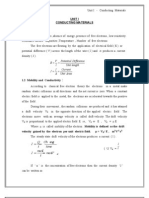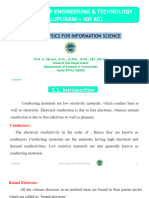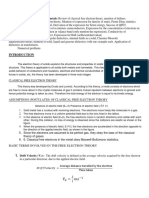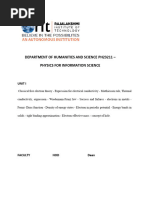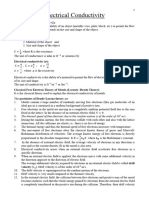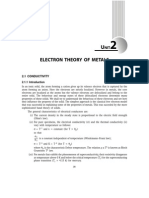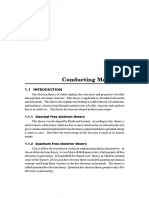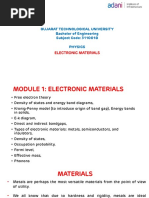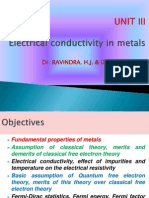21PHY12 Module 4 Notes
Uploaded by
Kushal Gayekwad21PHY12 Module 4 Notes
Uploaded by
Kushal GayekwadEngineering Physics Module - 4 21PHY12/22
Electrical Conductivity in Solids
Classical free electron theory: Drude- Lorentz theory & Assumptions, Expression for electrical
conductivity (no derivation), Failures of classical free-electron theory.
Quantum free electron theory: Assumptions, Density of states (no derivation), Fermi-energy,
Fermi factor & its temperature dependence, Fermi - Dirac Statistics, Expression for electrical
conductivity (derivation), Merits of Quantum free electron theory.
Physics of Semiconductors: Fermi level in intrinsic semiconductors, Expression for
concentration of electrons in conduction band, Holes concentration in valance band (only mention
the expression), Conductivity of semiconductors (derivation), Hall effect, Expression for Hall
coefficient (derivation).
Dielectrics: Electric dipole, Dipole moment, Polarization of dielectric materials, Types of
polarizations. Qualitative treatment of Internal field in solids for one dimensional infinite array
of dipoles (Lorentz field). Claussius-Mossotti equation (derivation), Numerical problems.
08 Hours
DEPT. OF PHYSICS, ATRIA IT, BENGALURU-24 1
Engineering Physics Module - 4 21PHY12/22
Electrical Conductivity in Solids
Introduction
The atom consists of fundamental particles such as electrons, protons and neutrons. The
protons and neutrons are collectively known as nucleons. Electrons are revolving around the
nucleus in a permitted orbits. The electrons present in the outermost orbit is called valence
electrons, these valence electrons determine the physical properties like electrical, optical, thermal
and magnetic properties of solids (conductors, semiconductors and insulators). These properties
can be explained on the basis of free electron gas model.
Review of classical free electron theory
The classical free electron theory was proposed by German physicist Paul Drude in 1900 and
later improved by H.A. Lorentz, to explain the electrical conductivity in metals.
Drude – Lorentz Theory
Assumptions of classical Free electron Theory
• All metals contain a large number of free electrons which move freely through the
positive ionic core of the metals under the influence of an applied electric field hence
they are also called as conduction electrons.
• The free electrons are treated as equivalent to gas molecules which have three degrees
of freedom. Hence, the laws of classical kinetic theory of gases can be applied to the
free electrons.
• In the absence of the electric field, the kinetic energy associated with an electron at a
3
temperature T is given by 2 kT, where k is the Boltzmann constant
1 2 3
m𝑉𝑡ℎ = 2 𝑘𝑇
2
Where 𝑉𝑡ℎ is the thermal velocity. It is same as root mean square velocity
• The motion of the free electrons obey the Maxwell-Boltzmann velocity distribution law
and laws of kinetic theory of gases.
• The electric field (or potential) due to the positive ionic cores is considered to be
constant.
• The repulsion between the free electrons is considered to be negligible.
• The free electrons are non-interacting and obey Pauli’s exclusion principle.
• The electric current flows in a metal due to external applied electric field is a
significance of the drift velocity of the electrons in a direction opposite to the direction
of the field.
The expression for electrical conductivity (σ) based on classical free electron theory is given by,
𝑛𝑒 2 𝜏
𝜎=
𝑚
where, n →number of free electrons per unit volume (electron concentration)
e →charge on the electron
→relaxation time of the free electrons
m →mass of electron
DEPT. OF PHYSICS, ATRIA IT, BENGALURU-24 2
Engineering Physics Module - 4 21PHY12/22
Failures of classical free electron theory
Drude-Lorentz theory successfully explained the conductivity of metals, but it failed to explain
some experimentally observed behavior of metals with respect to electrical conduction. Three
such failures are,
• Specific heat.
The molar specific heat of a gas at constant volume is given by
3
𝐶𝑣 = 2 𝑅 where R is a universal gas constant.
But experimentally it was observed that specific heat of a metal by its conduction electrons is given
by 𝐶𝑣 = 10−4RT
Thus, the experimental value of 𝐶𝑣 is very much lesser than the expected value of 𝐶𝑣 . According to
classical free electron theory 𝐶𝑣 is independent of temperature, but the experimental value of 𝐶𝑣 is
directly proportional to temperature. Hence classical free electron theory fails to explain about
specific heat of a metal at constant volume 𝐶𝑣 .
• Temperature dependence of electrical conductivity.
we know that experimentally conductivity of a metal varies inversely with temperature
1
T i.e 𝜎 ∝
𝑇
But according to classical free electron theory one arrives at the condition,
1
which is not correct.
• Dependence of electrical conductivity on electron concentration.
➢ As per the equation of conductivity, σ α n. But it can be observed that some of
the metals as shown in table having lesser 'n' value exhibits high σ values and
some of the metals having very high 'n' value exhibits lesser σ values. This
shows that there is no correlation between conductivity and electron concentration.
➢ Thus, it clears that the prediction σ α n doesn't always hold good.
Metal σ (×107) /Ωm n (×1028) m-3
Silver 6.3 5.85
Copper 5.88 8.45
Aluminum 3.65 18.06
Zinc 1.09 13.10
Cadmium 0.15 9.28
Quantum free electron theory
Arnold Sommerfeld proposed a new theory in 1928 by applying quantum mechanical
principles and succeeded in overcoming many of drawbacks of the classical free electron
theory. He treated electrons quantum mechanically and realized the role of Pauli's exclusion
principle in restricting the energy values of electron, and the theory given by him is known as
quantum free electron theory.
DEPT. OF PHYSICS, ATRIA IT, BENGALURU-24 3
Engineering Physics Module - 4 21PHY12/22
Assumptions of quantum free electron theory
• The energy values of the free electrons are quantized.
• The free electrons obey the Pauli's exclusion principle.
• Free electrons obey the Fermi Dirac quantum statistics.
• The free electrons travel under constant potential inside the metal and confine to the
boundaries of metal.
• The attraction between the free electrons and the lattice ions and the repulsion between
the electrons themselves are ignored.
• The free electrons are treated as wave-like particles.
Expression for Electrical conductivity based on quantum free electron theory
When an external electric field is applied to the metal, the force exerted on a free electron is
given by F = -eE (1)
𝑑𝑝
From newton’s second law force is given by F = (2)
𝑑𝑡
From equation (1) and (2)
𝑑𝑝
-eE = (3)
𝑑𝑡
According to de Broglie’s hypothesis,
ℎ
P=
𝜆
Multiply and divide by 2𝜋
ℎ 2π
P= = ħk (4)
2π 𝜆
ℎ 2π
Where ħ = and k =
2π 𝜆
Substituting for P in equation (3) we get,
𝑑 𝑑𝑘
-eE = (ħk ) = ħ
𝑑𝑡 𝑑𝑡
𝑒𝐸
dk = − 𝑑𝑡 (5)
ħ
The above equation (5) shows that, the origin of k space moves through a distance dk in time dt
on application of external electric field, E. due to collisions of free electrons with the
imperfections, the displacement of k space become steady(dk = Δk) and then the time dt changes
to dt = τc is the average collision time.
−𝑒𝐸
Δk = τ𝑐 (6)
ħ
DEPT. OF PHYSICS, ATRIA IT, BENGALURU-24 4
Engineering Physics Module - 4 21PHY12/22
Since p = 𝑚𝑒∗ v = ħk, where 𝑚𝑒∗ is the effective mass of electron, the change in velocity
(v→ ∆𝑉 ) ΔV is given by
ħ
Δv = Δk (7)
𝑚∗𝑒
ħ −𝑒𝐸𝜏𝑐 −eE c
Δv = ( )( ) k =
𝑚∗ 𝑒 ħ
−𝑒𝐸𝜏𝑐
Δv = (8)
𝑚∗𝑒
If the number of electrons per unit volume (electron density) is n, then the current density, J is
given by
J = n(-e)Δv (9)
Substituting for Δv in equation (9), we get
−𝑒𝐸𝜏𝑐
J = n(-e) ( )
ħ
𝑛𝑒 2 𝐸𝜏𝑐
J= (10)
𝑚𝑒∗
From Ohm’s law we have, J = σE (11)
Comparing equations(10) and (11)
𝑛𝑒 2 𝜏𝑐
σ= (12)
𝑚𝑒∗
ne 2
= ( ) ( c = ) (13)
me VF VF
where,
σ is the conductivity of the metal
n is the electron concentration
𝑚𝑒∗ is the effective mass of an electron
𝜏𝑐 is the mean collision time
λ is the mean free path.
VF is the fermi velocity
DEPT. OF PHYSICS, ATRIA IT, BENGALURU-24 5
Engineering Physics Module - 4 21PHY12/22
Density of states
The density of states g(E) can be defined as, "the number of available states per unit
energy range centered at a given energy E in the valence band of a material of unit volume".
It is mathematically continuous function and the product of g(E)dE gives the number of states
in the energy interval dE at E.
Let the material be of unit volume and the energy band be spread in an energy interval between
E1 and E2. Consider an infinitesimally small increment dE at an arbitrary energy value E in the
band (shown in figure). Since dE is an infinitesimally small increment in E, we can assume that
g(E) remains constant between E and E+dE. Then the number of energy states in the range E
and E+dE is obtained by evaluating the product of g(E) and dE.
8√2 𝜋𝑚3/2
The equation for density of states is given by, g(E)d(E) = [ ] 𝐸1/2 dE
ℎ3
Fermi energy
The top most energy level occupied electrons at absolute zero temperature is called
Fermi energy level and the energy corresponding to that energy level is called Fermi energy
(EF). Fermi energy represents the maximum energy that electrons can have at absolute zero
temperature.
Fermi-Dirac statistics and Fermi factor
The free electrons distributed among various energy levels in the energy bands by
obeying a statistical rule and is known as Fermi-Dirac statistics. It describe the distribution of
electrons among the various permitted energy levels of a material under thermal equilibrium.
Thus, the distribution of electrons among various energy levels is given by statistical function
f(E) known as Fermi factor. and is defined as follows,
"It is the probability of occupation of a given energy state for material in thermal
equilibrium".
The probability that a given energy state with energy E is occupied at a steady state temperature
T is given by,
1
f(E) = E−E
F
e kT +1
DEPT. OF PHYSICS, ATRIA IT, BENGALURU-24 6
Engineering Physics Module - 4 21PHY12/22
Variation of Fermi factor with energy and temperature
The dependence of Fermi factor on temperature and the effect on occupancy of
energy levels is shown in below figure.
Let us consider the different cases of distribution as follows.
(i) Probability of occupation for T = 0K and E<EF
1
We have, f(E) = E−E
F
e kT +1
1 1
f(E) = = 0+1 = 1
𝑒 −∞ +1
Hence the probability of finding an electron with energy E<EF is unity. i.e. all the energy
levels below the Fermi level are occupied.
(ii) Probability of occupation for T = 0K and E>EF
1
f(E) = E−EF
e kT +1
1 1 1
f(E) = = ∞+1 = ∞ = 0
𝑒 ∞ +1
A zero probability implies that there are no electrons having energy greater than EF. i.e. all
the energy levels above Fermi energy level are vacant.
(iii) Probability of occupation for T>0K and E = EF
1
We have, f(E) = E−EF
e kT +1
1 1 1
f(E) = = 1+1 = 2 = 0.5
𝑒 0 +1
For E<EF, the probability starts decreasing from 1 and reaches to 0.5 at E = EF and for E>EF
the probability value falls off to zero rapidly.
DEPT. OF PHYSICS, ATRIA IT, BENGALURU-24 7
Engineering Physics Module - 4 21PHY12/22
Fermi-Dirac distribution
The distribution of electrons among the various permitted energy levels of a material
according to Fermi-Dirac statistics under thermal equilibrium condition is called as Fermi-
Dirac distribution and is given by,
N (E)dE = Density of available states in the energy range E and (E+dE) × Probability of
occupation of these energy levels by the electron
i.e. N (E)dE = g(E)dE f (E)
where, N(E)dE is the number of electrons in unit volume which possess energy only in the
range E and E+dE
Fermi velocity (vF)
It is the velocity with which the electrons can occupy the Fermi level and is given by,
2EF 1/2
vF = ( )
m
Fermi temperature (TF)
It is the temperature at which the average thermal energy of the free electron in a solid
becomes equal to the Fermi energy at 0K. It is given by,
𝐸𝐹
TF =
𝐾
The Fermi temperature is only theoretical concept, since at ordinary temperatures, it is not
possible for the electrons to receive thermal energy in a magnitude of EF.
Mean free path (λ)
It is the average distance travelled by the conduction electrons between two
successive collisions with the lattice ions.
Success (Merits) of quantum free electron theory
• Specific heat
➢ According to quantum free electron theory, the only electrons that are occupying energy
levels close to EF can absorb the heat energy.
➢ From QFET, specific heat is given by
2k
CV = RT
EF
➢ Also experimentally specific heat is given by
CV = 10−4 RT
➢ If we take any value for EF then we get,
2k
10−4
EF
➢ This is in agreement with the experimentally observed values. Thus QFET successfully
explained about the low specific heat values for metals.
DEPT. OF PHYSICS, ATRIA IT, BENGALURU-24 8
Engineering Physics Module - 4 21PHY12/22
• Temperature dependence of electrical conductivity.
From quantum free electron theory the electrical conductivity for metals is given by
𝑛𝑒 2 λ
σ= ∗ (1)
𝑚𝑒 𝑉 𝑓
∗
Here the terms e and 𝑚𝑒 are constant, n and VF are independent of temperature but λ is
dependent on temperature. The nature of dependence of λ on T can be analyzed as
follows.
➢ The waves associated with the electrons are subjected to scattering by the vibrating
ions of the lattice. The vibrations occur in such a way that the ions displaces equally
in all directions.
➢ If r be the amplitude of such vibrations, then the ions can be considered to present
effectively a circular cross section of area πr2 that blocks the path of the electron
waves irrespective of the direction of approach.
➢ Increased scattering of waves result in a reduction in the value of mean free path
of the electrons.
1
λ= 2
𝜋𝑟
Now considering the facts that,
(i) The energy of a vibrating body is proportional to the square of the amplitude.
i.e. E α r2.
(ii) The energy of ions is due to thermal energy and the thermal energy is
proportional to the temperature i.e. E α T
∴r2 α T
1
Or λ∝
𝑇
Now from equation(1),
σ∝𝜆
1
𝜎∝
𝑇
Thus the dependence of σ on T is successfully explained by quantum free electron theory.
• Dependence of electrical conductivity on electron concentration.
As per quantum free electron theory the electrical conductivity for metals is given by,
𝑛𝑒 2 λ
σ= ∗
𝑚 𝑣𝑓
From the above equation it is clear that the value of σ depends on n, m* and the ratio
(λ/vF).
➢ If we compare the cases of copper and aluminium, the value of n for aluminium is 2.13
times greater than that of copper.
➢ But the value of (λ/vF) for copper is about 3.73 times higher than that of aluminum.
Further the value of m* for aluminum is 1.08 times greater than that of copper.
➢ Due to the inverse dependence of σ on m* calculations with respect to above values yield
results having electrical conductivity for copper greater than that of aluminum.
DEPT. OF PHYSICS, ATRIA IT, BENGALURU-24 9
Engineering Physics Module - 4 21PHY12/22
Physics of Semiconductor
Semiconductors are the class of materials whose conductivity values lies in between
that of conductors and insulators.
e.g. silicon (Si), germanium (Ge), gallium arsenide (GaAs), gallium phosphide (GaP) etc.
Intrinsic semiconductor
• Intrinsic semiconductors are pure semiconductors in which no chemical impurity atoms
are present.
• Its conductivity is low and can be varied by varying the temperature only.
• At absolute zero temperature an intrinsic semiconductor behaves like an insulator.
• In an intrinsic semiconductor the number of free electrons 'ne' and the number of holes
'nh' are always equal. i.e. ne=nh=ni where ni is called intrinsic carrier concentration.
• Common examples for intrinsic semiconductors are silicon (Si) and germanium (Ge).
Extrinsic semiconductor
• Extrinsic semiconductors are doped semiconductors which consists of suitable amount
of chemical impurities to increase the conducting properties.
• The process of adding impurity to a semiconductor is known as "doping" and the
impurities added are called as "dopants" or "doping agents".
• The conductivity can be easily modified and controlled by simply controlling the
amount of dopants which is added.
• Extrinsic semiconductors significantly have higher conductivities as compared to
intrinsic semiconductors.
• In an extrinsic semiconductor the number electrons and holes are not equal.
• There are two types of extrinsic semiconductors which are obtained from a pure
semiconductor by proper choice of dopants and they are,
(i) n-type semiconductor
It is an extrinsic semiconductor which is obtained by adding pentavalent impurities to
a pure semiconductor like phosphorous, antimony, arsenic etc. Here electrons are
majority charge carriers and holes are minority charge carriers, i.e. ne>>nh.
(ii) p-type semiconductor
P-type semiconductor is obtained by adding trivalent impurities to a pure semiconductor
like Aluminum, Boron, Indium etc. Here holes are majority charge carriers and
electrons are minority charge carriers, i.e. nh>> ne.
Fermi level in intrinsic semiconductor
• Fermi level is defined as the highest energy level below which all energy levels are filled
by electrons at temperature 0K.
• At absolute zero temperature intrinsic semiconductor acts as perfect insulator, as the
temperature increases due to thermal excitation electrons in the valence band jump to the
conduction band. (shown in below fig)
DEPT. OF PHYSICS, ATRIA IT, BENGALURU-24 10
Engineering Physics Module - 4 21PHY12/22
• Every time an electron moves from valence band to the conduction band, it leaves a hole
behind in the valence band. Thus the so created electron-hole pairs are responsible for
conduction.
• The number of holes in the valence band is equal to the number of electrons in the conduction
band. Hence, the probability of occupation of energy levels in conduction band and valence
band are equal.
Carrier concentration in an intrinsic semiconductor
The number of charge carriers per unit volume of the material is called carrier
concentration.
The number of electrons in the conduction band per unit volume of the material is
called as electron concentration.
The number of holes in the valence band per unit volume of the material is called as
hole concentration.
Expression for electron concentration (ne)
The expression for electron concentration (ne) is given by,
𝐸𝐹−𝐸𝑔
4√2 ( 𝑘𝑇 )
𝑛𝑒 = (𝜋𝑚𝑒∗ 𝑘𝑇) 3/2
𝑒
ℎ3
Where, 𝑚𝑒∗ is the effective mass of electron
k is Boltzmann constant
EF is Fermi energy
h is Planck’s constant
T is Temperature in kelvin
Eg is Energy gap
Expression for hole concentration (nh)
The expression for hole concentration (𝑛ℎ ) is given by,
−𝐸
4√2 ( 𝑘𝑇𝐹 )
𝑛ℎ = (𝜋𝑚ℎ∗ 𝑘𝑇)3/2 𝑒
ℎ3
Where, 𝑚ℎ∗ is effective mass of hole
DEPT. OF PHYSICS, ATRIA IT, BENGALURU-24 11
Engineering Physics Module - 4 21PHY12/22
h
Relation between Fermi energy and energy gap for an intrinsic semiconductor
We know that the expressions for electron concentration (ne) and hole concentration
(nh) are given by,
𝐸𝐹−𝐸𝑔
4 √2 ( 𝑘𝑇 )
𝑛𝑒 = (𝜋𝑚𝑒∗ 𝑘𝑇) 3/2
𝑒 (1)
ℎ3
𝐹 −𝐸
4√2 ∗ 3/2 ( 𝑘𝑇 )
𝑛ℎ = (𝜋𝑚 ℎ 𝑘𝑇) 𝑒 (2)
ℎ3
For an intrinsic semiconductor, the number of holes per unit volume in valence band is equal
to the number electrons per unit volume in the conduction band.
i.e. ne = nh
equating(1) and (2)
𝐸𝐹−𝐸𝑔
( 𝑘𝑇 ) −𝐸
𝐹
4√2 4√2 ∗ 3/2 ( 𝑘𝑇 )
(𝜋𝑚𝑒∗ 𝑘𝑇) 3/2
𝑒 = (𝜋𝑚 ℎ 𝑘𝑇) 𝑒
ℎ3 ℎ3
𝐸𝐹−𝐸𝑔
( 𝑘𝑇 ) −𝐸
𝐹
∗ 3/2 ∗ 3/2 ( 𝑘𝑇 )
(𝑚𝑒 ) 𝑒 = (𝑚ℎ ) 𝑒
2𝐸𝐹−𝐸𝑔
( ) ∗
𝑚ℎ
Or 𝑒
𝑘𝑇
= ( ∗ )3/2
𝑚𝑒
Taking natural logarithm on both sides we get,
2𝐸𝐹−𝐸𝑔 3 𝑚∗ℎ
( 𝑘𝑇
) = 2 ln ( 𝑚∗ )
𝑒
3 𝑚∗ℎ
2EF = kTln (𝑚∗ ) + Eg
2 𝑒
3 𝑚∗ℎ Eg
EF = kTln ( 𝑚∗ ) + 2
4 𝑒
∗
Under practical considerations, 𝑚𝑒 = 𝑚ℎ∗ , so that the first term in the RHS of the above
equation goes to zero (i.e ln1=0)
𝐸𝑔
EF =
2
Thus, the Fermi level is in the middle of the band gap for an intrinsic semiconductor.
DEPT. OF PHYSICS, ATRIA IT, BENGALURU-24 12
Engineering Physics Module - 4 21PHY12/22
Electrical Conductivity in an intrinsic semiconductors
Consider a semiconductor of area of cross section 'A' through which a current 'I' is
flowing and 'v' be the velocity of electrons whose flow constitutes the electric current. The
volume swept by the electrons per second = Av. If ne is the number of electrons per unit volume
and 'e' is the magnitude of electric charge on the electron, then the charge flow per second
which is nothing but current is given by,
𝐼 = 𝑛𝑒 𝑒𝐴𝑣 (1)
𝐼 𝑛𝑒 𝑒𝐴𝑣
We know that Current density J= =
𝐴 𝐴
J = 𝑛𝑒 𝑒𝑣 (2)
𝑣
The electron mobility is given by 𝜇𝑒 =
𝐸
𝑣 = 𝜇𝑒 𝐸 (3)
Substituting (3) in (2) 𝐽 = (𝑛𝑒 𝑒𝜇𝑒 )E (4)
But from Ohm’s law 𝐽 = 𝜎𝑒 𝐸 (5)
Where 𝜎𝑒 is the conductivity due to electrons in the semiconductor material.
Comparing (4) and (5) 𝜎𝑒 = 𝑛𝑒 𝑒𝜇𝑒
Similarly if we solve for conductivity due to holes we will get an expression
𝜎ℎ = 𝑛ℎ 𝑒𝜇ℎ
We know that the total conductivity of a semiconductor is due to flow of electrons and holes,
i.e σ = σe + σh
σ = 𝑛𝑒 𝑒𝜇𝑒 + 𝑛ℎ 𝑒𝜇ℎ
σ = e(𝑛𝑒 𝜇𝑒 + 𝑛ℎ 𝜇ℎ )
For an intrinsic semiconductor we have, 𝑛𝑒 = 𝑛ℎ = 𝑛𝑖
𝜎 = 𝑛𝑖 𝑒(𝜇𝑒 + 𝜇ℎ )
Hall effect
When a material carrying a current is placed in a transverse magnetic field, an electric
field is induced across the material in a direction perpendicular to both the direction of the
magnetic field and the direction of current flow. This phenomenon is called as Hall effect and
the voltage generated is called as Hall voltage.
Theory
• Consider a rectangular slab of n-type semiconductor material in which current I is
flowing in the positive X-direction.
• Let a magnetic field B be applied along Z-direction, i.e. perpendicular to the direction
of current flow (shown in below figure) the electrons experience a force known as
Lorentz force (FL) and is given by
DEPT. OF PHYSICS, ATRIA IT, BENGALURU-24 13
Engineering Physics Module - 4 21PHY12/22
FL = −Bev (1)
where, e →The magnitude of charge on electron
v →The drift velocity of electrons
• Applying Flemings left hand rule, we see that the force is exerted on electrons in the
negative Y-direction.
• Thus the electrons are deflected downwards and the electron density increases at the
bottom face of the slab so it becomes negatively charged.
• On the other hand, the loss of electrons on the upper face of the slab causes the top face
of the material to become positively charged.
• Hence a potential VH known as Hall voltage is developed across the bottom and top
faces of the slab, which establishes an electric field EH called as Hall field in the negative
Y-direction.
• The field EH exerts an upward force FH on the electrons and is given by,
FH = −eEH (2)
• As the deflection of electron continues in the downward direction due to FL and is also
contribute to the growth of Hall field. Thus, the force FH which acts on the electron in
the upward direction also increases.
• These two opposing forces reach an equilibrium at which stage,
FL = FH
From equations (1) and (2)
−Bev = −eEH
EH = Bv (3)
If d is distance between the top and bottom faces of the slab then,
𝑉ℎ
𝐸𝐻 =
𝑑
or from equation (3) we have
VH = EH d
DEPT. OF PHYSICS, ATRIA IT, BENGALURU-24 14
Engineering Physics Module - 4 21PHY12/22
VH = Bvd (4)
Let w be the width or thickness of the material in Z-direction, then its area of cross
section normal to direction of I is A = wd.
𝐼
∴ The current density, J =
𝐴
𝐼
J= (5)
𝑤𝑑
𝐽 = 𝑛𝑒𝑣 = 𝜌𝑣 (6)
We know that, n is the charge carrier concentration
ρ is the charge density
from equation (5) and (6) we have,
𝐼
𝜌𝑣 =
𝑤𝑑
𝐼
𝑣= (7)
𝜌𝑤𝑑
Substitute equation (7) in (4)
𝐵𝐼
VH = (8)
𝜌𝑤
𝐵𝐼
𝜌= (9)
𝑉𝐻 𝑤
Hall co-efficient (RH)
For a given semiconductor, the hall field EH depends upon the current density J and the applied
magnetic field B.
i.e EH ∝ 𝑱𝑩
or EH = RHJB
where, RH is the Hall coefficient
From above equation we can have,
𝐸𝐻
𝑅𝐻 = (10)
𝐽𝐵
Substitute for EH and J from equation (3) and (6)
𝐵𝑣
𝑅𝐻 =
𝜌𝑣𝐵
1 1
Or 𝑅𝐻 = = (11)
𝜌 𝑛𝑒
Thus, the hall coefficient can be evaluated, once ρ is known
We have from equation (8)
𝐵𝐼
𝑉𝐻 =
𝜌𝑤
1 𝐵𝐼 1
𝑉𝐻 = ( ) since, (𝑅𝐻 = )
𝜌 𝑤 𝜌
𝐵𝐼
𝑉𝐻 = 𝑅𝐻 ( )
𝑤
DEPT. OF PHYSICS, ATRIA IT, BENGALURU-24 15
Engineering Physics Module - 4 21PHY12/22
Dielectric materials
• A dielectric material is an electrical insulator that can be polarized by an applied electric
field.
• There are no free charge carriers in dielectric material but having a positive and negative
charges which are tightly bound to the nuclei.
• When a dielectric material is placed in an electric field the charges in the molecule
slightly shift from their positions causing dielectric polarization.
• Because of dielectric polarization, positive charges are displaced in the direction of the
applied field and negative charges shift in the direction opposite to the field.
Electric dipole and Dipole moment
• A pair of equal and opposite charges separated by a small distance is known as
electric dipole (shown in below figure).
• The product of magnitude of one of the charges and distance between the two charges
is known as the dipole moment ( 𝜇⃗ ) i.e
𝜇⃗ = 𝑄𝑙
• A dipole moment is a vector directed from –Q to +Q
Polar and Non-polar dielectrics
Polar dielectrics
• The dielectric materials in which the effective centres of the positive and negative
charges in the atoms or molecules do not coincide with each other even in the absence
of electric field are known as polar dielectrics.
e.g.: Water, HCl, NH3 etc.
• The atoms or molecules behaves as an electric dipole and possesses an intrinsic
permanent dipole moment.
• The electric dipoles of a polar dielectric are oriented randomly due to thermal agitations,
which results in a net zero dipole moment for the material as a whole in the absence of
an external electric field.
• Under the presence of an electric field, the polar molecules tends to rotate and align in
the direction of the applied field (shown in below figure).
DEPT. OF PHYSICS, ATRIA IT, BENGALURU-24 16
Engineering Physics Module - 4 21PHY12/22
Non-polar dielectrics
• The dielectric materials in which the effective centres of the positive and negative
charges in the atoms or molecules coincide with each other in the absence of electric
field are known as non-polar dielectrics.
e.g.: O2, N2, H2 etc.
• Non-polar dielectrics get polarized only by the application of external electric field thus
they exhibit induced electric dipole moment.
• When an electric field is applied, the positive charge experiences a force in a direction
of the applied field whereas negative charge experiences a force in a direction opposite
to that of the applied field hence positive and negative charge centres get separated
(shown in below figure).
The molecules are now said to acquire an induced dipole moment which is directly
proportional to the applied electric field.
E
Polarization
• "The displacement of charges in the atoms or molecules of a dielectric material under
the action of an external electric field leading to the development of dipole moment is
called as polarization of a dielectric or electric polarization".
• Thus the polarization referred to a process of producing electric dipoles, i.e. the
separation of positive and negative charges inside the dielectric material by the
application of an external electric field.
Types of polarization
There are mainly three different mechanisms through which electric polarization can
occur in dielectric materials when they are subjected to an external electric field. Accordingly
three different types of polarization are identified and they are,
(i) Electronic or Induced polarization
• The electronic polarization occurs due to the displacement of positive and negative
charges in a dielectric material due to the application of an external electric field.
E
E=0 E≠0
• The separation created between the charges leads to the development of a dipole
DEPT. OF PHYSICS, ATRIA IT, BENGALURU-24 17
Engineering Physics Module - 4 21PHY12/22
moment and the process is called electronic or induced polarization.
• The electronic polarizability αe for a rare gas atom is given by,
𝜖0 (𝜖𝑟 −1)
𝛼𝑒 = 𝑁
Where, 𝜖0 is the permittivity of free space
𝜖𝑟 is relative permittivity of the medium
N is number of atoms per unit volume
(ii) Ionic or Atomic polarization
• Ionic polarization occurs only in those dielectric materials which possess ionic bonds
like NaCl, CaCO3, LiBr etc.
• When ionic solids are placed in an applied external electric field, there is a displacement
of positive ions in the direction of the applied field whereas negative ions displaced in
a direction opposite to that of the applied field (shown in below figure).
• This results in formation of electric dipoles and the process is known as ionic or atomic
polarization.
E
E=0 E≠0
(iii) Orientational polarization
• Orientational polarization occurs in the dielectric materials which have permanent
dipole moment (i.e. polar dielectrics).
• In the absence of an external electric field these dipoles are randomly oriented due to
the thermal agitation. Thus, the material has net zero dipole moment.
• In the presence of an external electric field, each of the dipoles undergo rotation so as
to reorient along direction of the applied field and the material itself develops electrical
polarization (shown in below figure).
• This polarization is strongly temperature dependent and decreases with increase of
temperature.
E
E=0 E≠0
DEPT. OF PHYSICS, ATRIA IT, BENGALURU-24 18
Engineering Physics Module - 4 21PHY12/22
Dielectric Constant
• The characteristics of a dielectric material are determined by a factor known as dielectric
constant and is also measure of polarization of dielectrics
• It is a quantity measuring the ability of substance to store electrical energy in an electric
field.
• "The ratio of permittivity of the medium (ε) to the permittivity of free space (ε0) is known
as the dielectric constant or relative permittivity (εr) of the medium". i.e.
𝜖
𝜖𝑟 =
𝜖0
Relation between polarization and dielectric constant
⃗⃗ of a material is given by,
The relation between dielectric constant (εr) and polarization P
⃗⃗ = 𝜖0 (𝜖𝑟 − 1)𝐸⃗⃗
P
Here, (𝜖𝑟 − 1) is the dimensionless quantity known as the dielectric susceptibility
⃗P⃗ = 𝜖0 𝐸⃗⃗
Where, 𝐸⃗⃗ is the applied electric field
Internal fields
• When a dielectric material is subjected to external electric field, it gets polarized i.e. each
of the atoms develops a dipole moment and acts as electric dipoles.
• The resultant field at any given atom will be the sum of applied electric field and electric
field due to the surrounding dipoles.
• This resultant local field is known as internal field and is defined as follows, "It is the
electric field that acts at the site of any given atom of a solid or liquid dielectric subjected
to an external electric field and is the resultant of the applied field and field due to all the
surrounding dipoles".
Note
Polarizability : The dipole moment of an atom of a dielectric material is directly proportional to
the electric field applied to the atom.
i.e 𝜇 = 𝛼𝐸
where 𝛼 is the ploarizability of the atom of a dielectric material.
DEPT. OF PHYSICS, ATRIA IT, BENGALURU-24 19
Engineering Physics Module - 4 21PHY12/22
Expression for internal field in 1D and 3D
• Consider a linear array of equidistant atoms in an electric field E (shown in below
figure)
• Let the inter-atomic distance be d, and the electronic polarizability of the dipoles be αe
then the expression for the internal field Ei is given by,
𝐸
𝐸𝑖 =
1.2𝛼𝑒
1−
π𝜖0 𝑑3
Here, 𝛼𝑒 , E, 𝜖0 and d are all positive quantities thus, Ei > E
• The above equation is obtained by considering 1D array of atoms but in 3D the general
equation for internal field is expressed as
𝛾
𝐸𝑖 =E + ( ) 𝑃
𝜖0
where, P →Polarization
→is a proportionality constant called as internal field constant
1
In the 3-dimensional case if it is a cubic lattice then we have 𝛾 = and internal field
3
named as Lorentz field and is given by,
𝑃
𝐸𝑙𝑜𝑟𝑒𝑛𝑡𝑧 = 𝐸 + ( )
3𝜖0
Clausius-Mossotti equation
Clausius-Mossotti equation is a mathematical relation expresses the dielectric constant
(εr) of a material in terms of electronic polarizability (αe) of atoms in a dielectric material.
Consider a dielectric material of dielectric constant εr and 'N' be the number atoms per unit
volume of a dielectric material. Then the atomic dipole moment per unit volume which is called
as polarization (P) and is given by,
P = NeEi (1)
where, αe →electronic polarizability of dipoles we know that the Lorentz field is given by,
𝑃
𝐸𝑖 = 𝐸 + ( ) (2)
3𝜖0
DEPT. OF PHYSICS, ATRIA IT, BENGALURU-24 20
Engineering Physics Module - 4 21PHY12/22
Substitute equation (2) in (1)
𝑃
𝑃 = 𝑁𝛼𝑒 (𝐸 + )
3𝜖0
𝑁𝛼𝑒
𝑃= (3𝜖0 𝐸 + 𝑃)
3𝜖0
Nαe P
or = (3)
3ϵ0 (3ϵ0 +P)
The relation between polarization P and dielectric constant εr is,
P = 0 ( r −1) E (4)
Substitute equation (4) in (3)
Nαe 𝜖0 (𝜖𝑟 − 1)𝐸
=
3ϵ0 3𝜖0 𝐸 + 𝜖0 (𝜖𝑟 − 1)𝐸
Nαe 𝜖0 (𝜖𝑟 − 1)𝐸
=
3ϵ0 3𝜖0 𝐸 + 𝜖0 𝜖𝑟 𝐸 − 𝜖0 𝐸
Nαe 𝜖0 𝐸(𝜖𝑟 − 1)
=
3ϵ0 𝜖0 𝐸[3 + 𝜖𝑟 − 1]
Nαe (𝜖𝑟 − 1)
=
3ϵ0 (𝜖𝑟 + 2)
The above expression is called Clausius-Mossotti equation.
Solid, Liquid and Gaseous dielectrics
Dielectric materials can be any of the three states of matter, viz., solid, liquid or gaseous.
A brief description of these three types is as follows.
(i) Solid dielectrics
Solid dielectrics are available in extremely diverse variety and most using dielectrics in
engineering applications. These materials come in two types: organic materials such as paper,
wood, rubber and inorganic materials such as mica, glass, porcelain and synthetic polymers like
PVC, epoxy resins etc. Solid dielectrics have high mechanical strength and resistant to thermal
and chemical degradation. They are mainly used for insulating electrical components.
(ii) Liquid dielectrics
Liquid dielectrics are in the form of liquid state and performing two functions viz.,
providing electrical insulation and acting as coolant or heat dissipation. They come in two types:
DEPT. OF PHYSICS, ATRIA IT, BENGALURU-24 21
Engineering Physics Module - 4 21PHY12/22
organic materials such as mineral oils like transformer oil, capacitor oil etc. and other
hydrocarbon based materials like asphalt, silicon oils, bitumen etc. and inorganic materials like
highly purified water, liquid nitrogen, helium etc.
(iii) Gaseous dielectrics
Gaseous dielectrics are in the form of gas and are used for insulation and cooling
purposes. The most common dielectric gas is air which provides insulation between the overhead
transmission power line without any cost. Other dielectrics in gaseous form include
nitrogen, hydrogen, helium sulphur hexafluoride etc. They are used in electrical applications
similar to liquid dielectrics.
Application of dielectrics in transformer
• A transformer is a device used for transmission and distribution of electrical power.
• In a transformer the energy is transferred from primary coil to secondary coil through
magnetic induction and not by any electrical path thus the insulation becomes most
critical part of a transformer.
• In order to avoid electrical conduction, dielectric insulators are used at all possible
locations.
• Further during the energy conversion process, losses occur in the windings and the core
of a transformer.
• These losses appear as heat leading to an increase in the temperature of the windings and
the core.
• The dielectrics employed in the transformer absorb and dissipate the heat generated to
the surrounding medium. Hence they are acting as an insulator as well as cooling agent.
• A few insulating materials present in a transformer are transformer oil/mineral oil,
insulating paper, insulating tape, wood based laminates etc.
DEPT. OF PHYSICS, ATRIA IT, BENGALURU-24 22
You might also like
- UNIT - 1 (Electronic Materials) : ConductorsNo ratings yetUNIT - 1 (Electronic Materials) : Conductors52 pages
- Module 2 - Lecture Notes - Engineering PhysicsNo ratings yetModule 2 - Lecture Notes - Engineering Physics40 pages
- Unit IV.2.Free Electron Theory of MetalsNo ratings yetUnit IV.2.Free Electron Theory of Metals16 pages
- Postulates of The Theory: 1900s Paul Drude Electrons Kinetic TheoryNo ratings yetPostulates of The Theory: 1900s Paul Drude Electrons Kinetic Theory9 pages
- Electrical Conductivity - Notes (November-2017) PDFNo ratings yetElectrical Conductivity - Notes (November-2017) PDF22 pages
- Electron Theory of Metals by Mr. CHARIS ISRAEL ANCHANo ratings yetElectron Theory of Metals by Mr. CHARIS ISRAEL ANCHA12 pages
- module-4-electrical-properties-of-materials-applications-01No ratings yetmodule-4-electrical-properties-of-materials-applications-0117 pages
- Unit 3 - ELECTRICAL PROPERTIES OF MATERIALSNo ratings yetUnit 3 - ELECTRICAL PROPERTIES OF MATERIALS16 pages
- 6262_Study_Material_Semiconductor_Physics__BBS00015_Module_II_part_1[revised]No ratings yet6262_Study_Material_Semiconductor_Physics__BBS00015_Module_II_part_1[revised]10 pages
- Unit I Conducting Materials - Simple FormNo ratings yetUnit I Conducting Materials - Simple Form21 pages
- Module 3 - Electrical Properties of Materials 2024 ShubhaNo ratings yetModule 3 - Electrical Properties of Materials 2024 Shubha34 pages
- Unit I Electrical Properties of Materials PDFNo ratings yetUnit I Electrical Properties of Materials PDF39 pages
- Chapter 8: Band Theory of Solids Concept of Free Electron Theory: Hour 1No ratings yetChapter 8: Band Theory of Solids Concept of Free Electron Theory: Hour 125 pages
- ECE 1109 - Electrical Properties of SolidNo ratings yetECE 1109 - Electrical Properties of Solid35 pages
- Electron Theory of Metals: 2.1 ConductivityNo ratings yetElectron Theory of Metals: 2.1 Conductivity32 pages
- Gujarat Technological University Bachelor of Engineering Subject Code: 3110018 PhysicsNo ratings yetGujarat Technological University Bachelor of Engineering Subject Code: 3110018 Physics22 pages
- Electrical Properties of Materials Mod-1No ratings yetElectrical Properties of Materials Mod-118 pages
- Applied Physics Unit 3 Notes (Elec & Diele) CS StreamNo ratings yetApplied Physics Unit 3 Notes (Elec & Diele) CS Stream20 pages
- Ever Smaller: Nature's Elementary Particles, From the Atom to the Neutrino and BeyondFrom EverandEver Smaller: Nature's Elementary Particles, From the Atom to the Neutrino and BeyondNo ratings yet
- On the quantum theory of radiation and the structure of the atomFrom EverandOn the quantum theory of radiation and the structure of the atomNo ratings yet
- Call Up Letter SCC Bhopal For Nda 148 Army and Navy and Na 110 Jul 2022 Course)No ratings yetCall Up Letter SCC Bhopal For Nda 148 Army and Navy and Na 110 Jul 2022 Course)19 pages
- Nano and Biomaterials Compounds Properties Characterization and Applications 1st Edition Zhypargul Abdullaeva 2024 scribd downloadNo ratings yetNano and Biomaterials Compounds Properties Characterization and Applications 1st Edition Zhypargul Abdullaeva 2024 scribd download55 pages
- Balsiger H. (Ed.) - Origin and Early Evolution of Comet Nuclei-Springer (2008)No ratings yetBalsiger H. (Ed.) - Origin and Early Evolution of Comet Nuclei-Springer (2008)312 pages
- UNIT-9 Coordination Compounds: Difference Between A Double Salt and A ComplexNo ratings yetUNIT-9 Coordination Compounds: Difference Between A Double Salt and A Complex21 pages
- Chapter II: Titrimetric Method of Analysis100% (1)Chapter II: Titrimetric Method of Analysis36 pages
- HSE Advisory - Chemicals For Cleaning Sanitisation and DisinfectionNo ratings yetHSE Advisory - Chemicals For Cleaning Sanitisation and Disinfection8 pages
- Solid Insulators in Vacuum: A Review (Invited Paper) : R Hawley, CNo ratings yetSolid Insulators in Vacuum: A Review (Invited Paper) : R Hawley, C8 pages
- Modul 2 Science Form 1 Chapter 2: Cell As A Unit of Life What Is Cell?No ratings yetModul 2 Science Form 1 Chapter 2: Cell As A Unit of Life What Is Cell?22 pages
- (Ebook) The Apocalypse Factory - Plutonium and the Making of the Atomic Age by Steve Olson ISBN 9780393634983, 9780393634976, 0393634981, 0393634973, 2020008293 all chapter instant download100% (5)(Ebook) The Apocalypse Factory - Plutonium and the Making of the Atomic Age by Steve Olson ISBN 9780393634983, 9780393634976, 0393634981, 0393634973, 2020008293 all chapter instant download81 pages
- Exp. 1 EFFECT OF FLOW RATE IN THE EFFECTIVENESS OF SHELLTUBE HEAT EXCHANGERNo ratings yetExp. 1 EFFECT OF FLOW RATE IN THE EFFECTIVENESS OF SHELLTUBE HEAT EXCHANGER6 pages
- Postulates of The Theory: 1900s Paul Drude Electrons Kinetic TheoryPostulates of The Theory: 1900s Paul Drude Electrons Kinetic Theory
- Electrical Conductivity - Notes (November-2017) PDFElectrical Conductivity - Notes (November-2017) PDF
- Electron Theory of Metals by Mr. CHARIS ISRAEL ANCHAElectron Theory of Metals by Mr. CHARIS ISRAEL ANCHA
- module-4-electrical-properties-of-materials-applications-01module-4-electrical-properties-of-materials-applications-01
- 6262_Study_Material_Semiconductor_Physics__BBS00015_Module_II_part_1[revised]6262_Study_Material_Semiconductor_Physics__BBS00015_Module_II_part_1[revised]
- Module 3 - Electrical Properties of Materials 2024 ShubhaModule 3 - Electrical Properties of Materials 2024 Shubha
- Chapter 8: Band Theory of Solids Concept of Free Electron Theory: Hour 1Chapter 8: Band Theory of Solids Concept of Free Electron Theory: Hour 1
- Gujarat Technological University Bachelor of Engineering Subject Code: 3110018 PhysicsGujarat Technological University Bachelor of Engineering Subject Code: 3110018 Physics
- Applied Physics Unit 3 Notes (Elec & Diele) CS StreamApplied Physics Unit 3 Notes (Elec & Diele) CS Stream
- Ever Smaller: Nature's Elementary Particles, From the Atom to the Neutrino and BeyondFrom EverandEver Smaller: Nature's Elementary Particles, From the Atom to the Neutrino and Beyond
- On the quantum theory of radiation and the structure of the atomFrom EverandOn the quantum theory of radiation and the structure of the atom
- Call Up Letter SCC Bhopal For Nda 148 Army and Navy and Na 110 Jul 2022 Course)Call Up Letter SCC Bhopal For Nda 148 Army and Navy and Na 110 Jul 2022 Course)
- Nano and Biomaterials Compounds Properties Characterization and Applications 1st Edition Zhypargul Abdullaeva 2024 scribd downloadNano and Biomaterials Compounds Properties Characterization and Applications 1st Edition Zhypargul Abdullaeva 2024 scribd download
- Balsiger H. (Ed.) - Origin and Early Evolution of Comet Nuclei-Springer (2008)Balsiger H. (Ed.) - Origin and Early Evolution of Comet Nuclei-Springer (2008)
- UNIT-9 Coordination Compounds: Difference Between A Double Salt and A ComplexUNIT-9 Coordination Compounds: Difference Between A Double Salt and A Complex
- HSE Advisory - Chemicals For Cleaning Sanitisation and DisinfectionHSE Advisory - Chemicals For Cleaning Sanitisation and Disinfection
- Solid Insulators in Vacuum: A Review (Invited Paper) : R Hawley, CSolid Insulators in Vacuum: A Review (Invited Paper) : R Hawley, C
- Modul 2 Science Form 1 Chapter 2: Cell As A Unit of Life What Is Cell?Modul 2 Science Form 1 Chapter 2: Cell As A Unit of Life What Is Cell?
- (Ebook) The Apocalypse Factory - Plutonium and the Making of the Atomic Age by Steve Olson ISBN 9780393634983, 9780393634976, 0393634981, 0393634973, 2020008293 all chapter instant download(Ebook) The Apocalypse Factory - Plutonium and the Making of the Atomic Age by Steve Olson ISBN 9780393634983, 9780393634976, 0393634981, 0393634973, 2020008293 all chapter instant download
- Exp. 1 EFFECT OF FLOW RATE IN THE EFFECTIVENESS OF SHELLTUBE HEAT EXCHANGERExp. 1 EFFECT OF FLOW RATE IN THE EFFECTIVENESS OF SHELLTUBE HEAT EXCHANGER




















